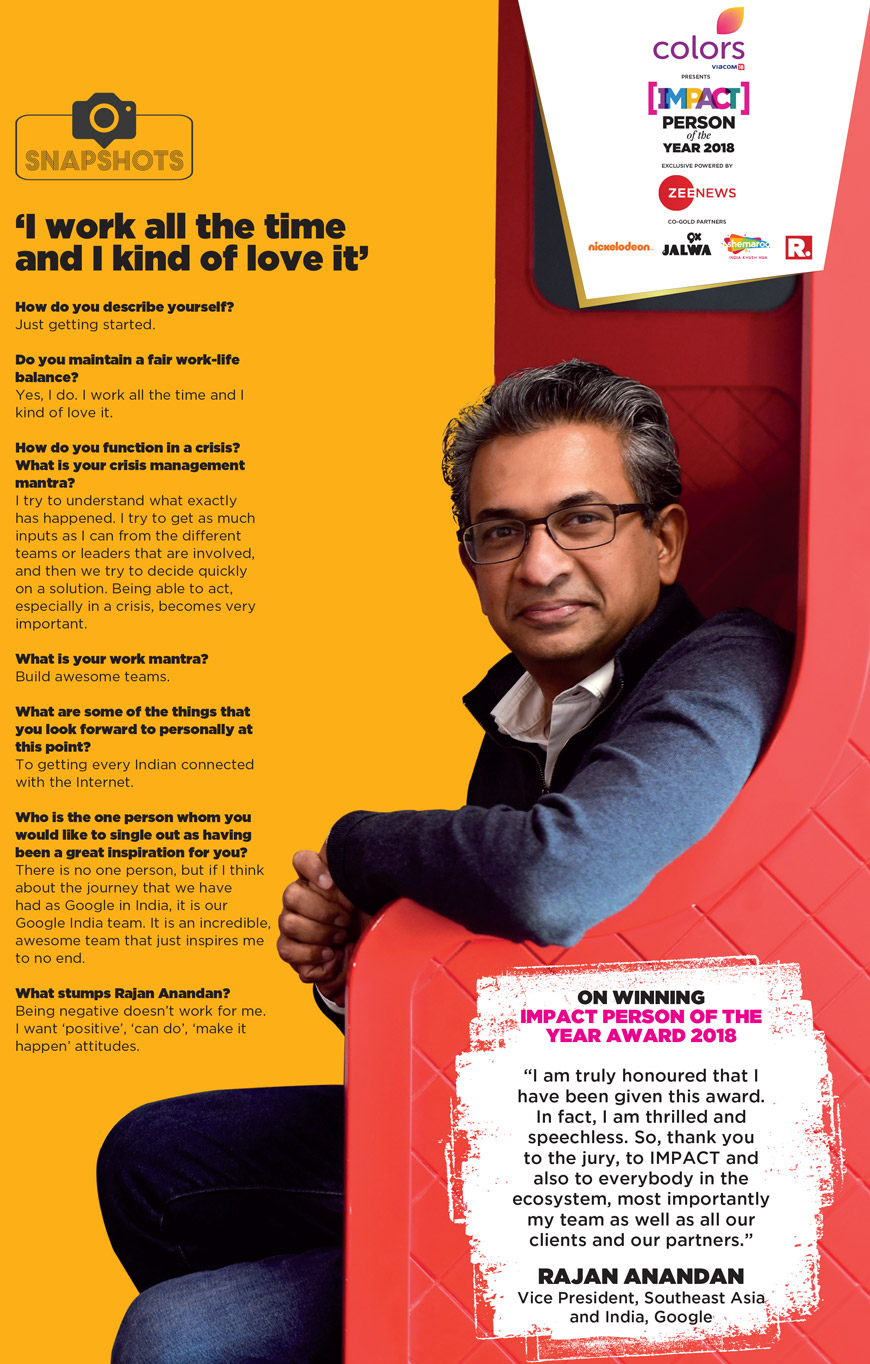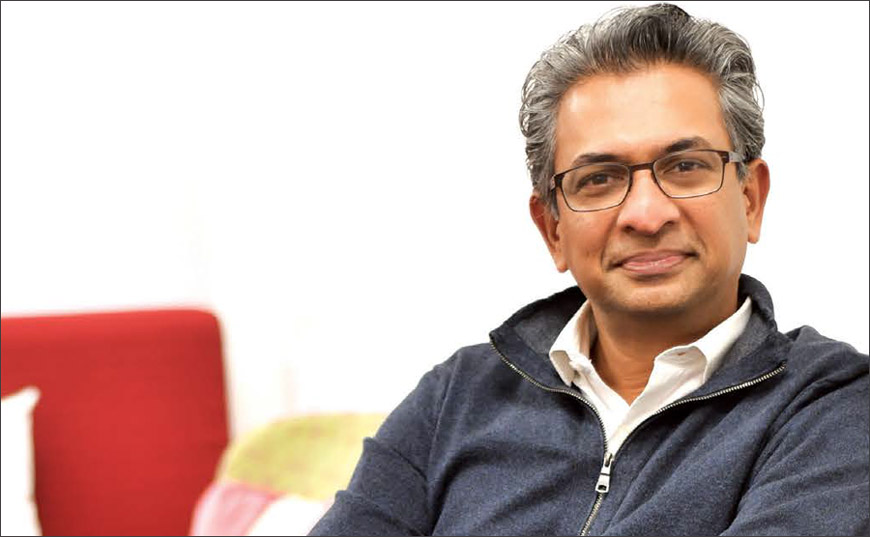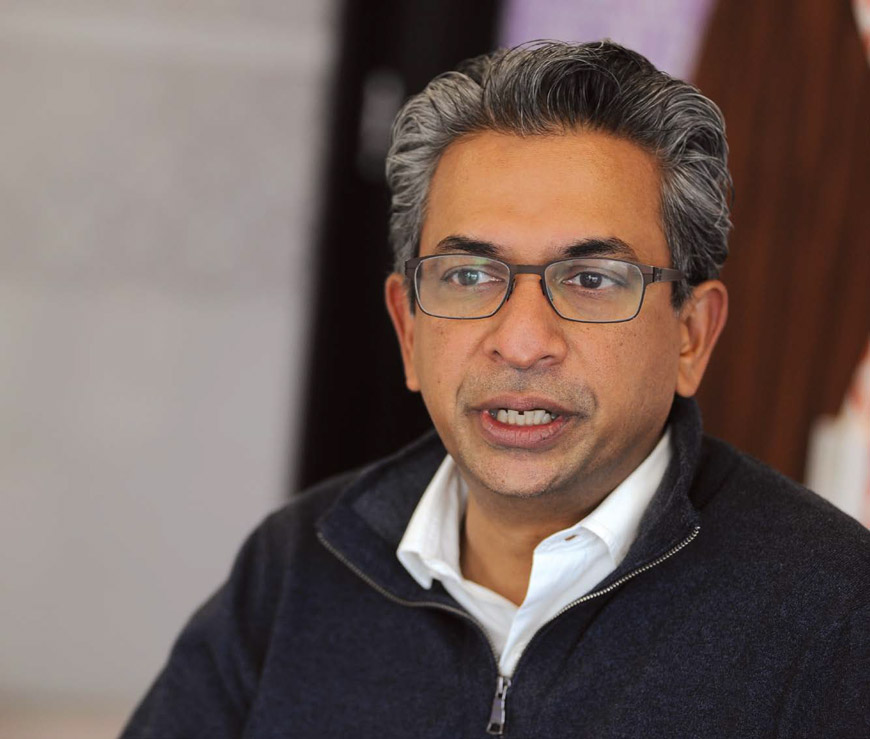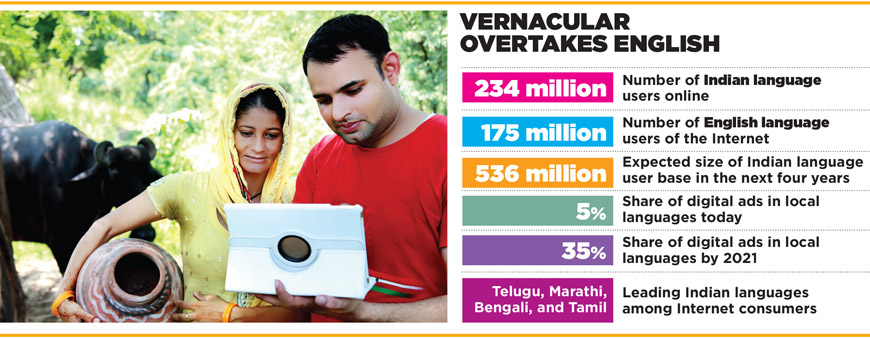The first time I used the Internet, I actually didn’t know it…
Working on programming at the Massachusetts Institute of Technology’s Athena labs in Cambridge in the early 1990s, the first time I used the Internet, I actually didn’t know I was on the Internet! It was before the launch of the commercial Internet as we know it, and it wasn’t called ‘the Internet’ at the time… that’s my earliest recollection. And then when the commercial Internet arrived, Netscape, Yahoo Mail… I remember buying some books in 1997-98 after Amazon had launched andhavingthem delivered… it was a magical experience… how you could order something and get it delivered at your doorstep. It’s incredible to see how the Internet has evolved.
As a child, I actually wanted to be a pilot…
When I was a child, I wanted to be a pilot, and fly planes. In fact, when I was 16, I actually took all the pilot training classes, but I was told afterwards that I was too young to take the test for a pilot’s licence. So, I lost interest in it and moved on to other things,otherwiseI would probably have been flying Jet Airways or something!
There is no one model of great leadership…
There are many different models of great leadership… no one model... What’s important is for everyone to find their authentic style of leadership, instead of trying to copy a style or a model because it’s successful… For me, a few things have been important. One, the ability to have along termvision, being able to say, ‘This is where we want to go’, and ‘This is why we want to go there’. Two, being able to build very strong teams… I think leaders build teams becauseatthe end of the day, that’s how you can actually build scale and velocity… Three, it’s very important to communicate clearly and communicate often, and without ambiguity. Four, it’s important for leaders to listen, and to be open to feedback, even if it is critical, and then be able to act on that feedback. The best leaders probably speak less and listen more. Five, the ability to quickly absorb data, listen to different points of view and make decisions quickly is very important in this technology era, because if you don’t make that decision, something would have happened, and before you know it, you are out of business. Lastly, being humble is very important.
I don’t think I have become a leader yet…
I don’t think I have become a leader yet, I am still working on it! You become better every day and at some point,may beyou become reasonably good. I wouldn’t say leadership but I started managing people when I was in my early 20s at McKinsey, where I became an engagement manager. That was the first time where I actually had to convince other people, depend on them to do things collectively and get things done. It was an incredible experience. I learnt how to motivate people, how to inspire them… I have had this incredible privilege of having worked with truly inspiring leaders that I have learnt a lot from. My view is, you can learn from everybody. And you should also seek out opportunities where you can learn from teams, from leaders… I am just very fortunate that I started my career at McKinsey with a set of really awesome leaders. Since then too, it’s been a journey of learning from other leaders.
Forcing ads on people - that idea’s time is gone…
It’s a very exciting time to be in the advertising and media ecosystem because there is so much change around us. On one hand, consumer behaviour is changing very dramatically and we have on anaverage400 million Indians who are spending 3-4 hours a day connected to the Internet. What they are doing online is changing. You have to deeply understand those changes to change your strategies. The new set of digital technologies is much more measurable - the effective ROI that you can get from them is very interesting. Programmatic is fascinating. There are going to be things that machines can do better than people. Machines can buy much more efficiently at scale than many people can. Creating and serving 10,000 creatives instantly across an audience is possible today. Hyper-targeting, hyper-personalization, hyper-efficiency, hyper-creatives at scale, targeted creatives at scale… it’s slowly moving towards this idea of ‘segment of one’ - please show me an ad that I want to see when I want to see it and let me control whether I want to see it or not. True view is a fantastic format because you decide whether you want to watch the ad or not. I don’t watch mainline media anymore because I don’t want to watch things I don’t want to watch. This idea of forcing ads on people – it’s time has gone.
I resonate with Google’s moonshot thinking…
I resonate a lot with Google’s moonshot thinking… the idea of 10x thinking. Most companies are trying to improve things 10%, trying to grow 10%, trying to reduce cost by 10% as opposed to 10x. The core belief around moonshot thinking is something that I deeply value, and I have tried to imbibe it in what we do, both personally as a leader, but more importantly in our teams. So, when we launched the ‘Internet Saathi’ initiative, we said, ‘India has 6,00,000 plus villages. We want to get to 300,000 villages with a physical network of ‘Internet Saathi’ in three years’. We have to remember we are Google, a digital company, and we don’t build physical networks of anything. And that we were going to do exactly that, was really a moonshot idea. Over the next year, we will certainly reach that target. We have embarked on many moonshots; some have worked, some have not. Another leadership philosophy is that it’s really important to take a risk. I never ‘play it safe’. People always remember the things you did well and your big successes. The only person who obsesses about all the other things, all the times you failed, is actually you. So, I don’t agonize about failure. I just focus on trying to go for the big wins.
Meetings are the death of speed…
I believe in speed. You need the singles and the doubles, but you know you want to be really going for the boundaries and the sixes. I think most companies have way too many meetings. So, one of the things I do say is ‘meetings are the death of speed’. And in most companies, most employees spend all their time in meetings. I don’t understand why they do it. It’s very important to be nimble, to be close to the market, to always be out there talking to your customers, partners… Also, to me, it’s very important to lead from the front, to really show the team that it can be done, especially when you are trying to go for these moonshot ideas… If you want everybody else to takerisk, but you are not takingrisk, then that doesn’t work, because nobody thinks that you are really serious about taking risks.
On a scale of 1 to 10, I rate myself at 0.5…
I think our journey has just begun. There is so much to be done. It’s just getting started… I am at 0.5 on a scale of 1 to 10!


‘I WANT TO SEE EVERY INDIAN ON THE INTERNET’
Rajan Anandan talks of his determination to get every Indian online, how the video explosion in India is different from that around the world, why you can take data safety for granted on Google and more…
Q] What are Google’s ambitions in India, and what is on your priority list right now?
Our mission for the last several years has been Internet for every Indian. So, we said this when India only had about 100 million users. Today, we are at 400 million Internet users and we have over almost a billion Indians to go. There are more than 900 million Indians who are not connected to the Internet. So, everything that we are doing in India is focused on how do we get Internet for every Indian. We have developed a very deep understanding of all the challenges and barriers there are to getting Indians online, and we are addressing them.
Q] Recently you identified voice, video and vernacular as the three driving forces of the Indian Internet ecosystem. How has the Internet landscape evolved of late?
The Indian Internet ecosystem has changed pretty dramatically over the last few years. As we speak, we have 400 million monthly active users on the Internet. One thing that we have observed over the last year or so is that a large number of Internet users who come to the Internet for the very first time are now accessing it primarily through voice. It’s a combination of voice technology or voice access getting much easier, both on regular smartphones like Android, and also Jio connected phones. Most people would much rather speak than type. And as computer technology has got very big on voice, that’s become the primary access point. Video is really exploding. We have over 250 million active users on YouTube in India. As mobile broadband has become more affordable - a gigabyte of 4G data has gone down from Rs 250 to Rs 25 a month. Video consumption has gone from being very expensive to quite affordable, and that’s driven this explosive growth in video. Lastly, local languages - these new Internet users are accessing the Internet and consuming content in local languages, both in video as well as text. So, 100% of new users that are coming on to the Internet today are only proficient in their own Indian languages, be it Hindi, Tamil, Kannada, Bangla or others. So, these are three very interesting trends among the new set of users who are coming online today.
Q] How is the video explosion in India different to what is happening around the world?
It’s different in a couple of interesting ways. First, there is just a lot more consumption of video. About 75% of data consumption on the Internet in India is video, and that’s very different to where India was a few years ago. It’s been entirely enabled by the affordable broadband revolution in India. The first thing that new Internet users do in India is consume video. India is the world’s first ‘video first’ and ‘voice first’ Internet. I don’t think there is a single country in the world where you can get a gigabyte of data for Rs 25. And that’s really driven this massive explosion in video.
Q] It’s predicted that by 2020, India will have more than 600 million people online. What does a connected society of that size and scale mean to you? And what are the opportunities… what can you expect to make of it?
We will certainly be at well north of 600 million users by the time we get to the end of 2020. But, even at 600 million, we are still less than half of India. The most important part of this is the consumers who are connected to the Internet. Internet in India is going to enable all users to get access to very high quality basic services to which many Indians today can’t get access. For example, if you take education, we don’t have enough schools, we certainly will never have enough teachers, enough physical schools to be able to deliver very high quality education. But, with digital, especially with data becoming much more affordable, you can actually develop and deliver very high quality education through online tutorials to hundreds of millions of Indians at scale. For something basic like learning English, India will never be able to build enough centres, or have enough English teachers. If you really want to have 500-600 million Indians proficient in English compared to 200 million today, the only way to do that is through digital. Even in healthcare, India will never have enough hospitals – but somebody sitting in a small village in Karnataka can get access to the best doctors sitting in Bangalore or for that matter anywhere in the world if they are connected to the Internet. Access to affordable healthcare is going to increase. Internet is going to be an enabler in many ways, beginning to solve some of India’s more severe challenges that also become opportunities, especially for Indian start-ups. For brands and marketers, it’s already a scale medium with YouTube at 250 million users. Today it’s got more reach in urban India than any TV channel. But, it can be very targeted, so you don’t have to target all 250 million. You can target basically the 10 million Indians who are going to buy a smartphone next month, and just target them with the messaging that you want. How brands will drive engagement, how they will acquire users as well as how they will support and service and engage after purchase with consumers will change dramatically. There will be an extraordinary opportunity for brands to do things very differently.
Q] With Google on every smartphone, sometimes users get a feeling that their privacy is invaded. Google knows everything. Is our data safe?
We take privacy very seriously; consumer privacy and consumer safety are most important for us. Many still don’t know that you can actually go to Google and see all the data that Google has on you as a consumer, and we give you the option to delete all that data at the tap of one button. Or you can take the data and import it to wherever you like. One, we want to be very transparent on what data we have on you. Two, we want to be transparent on how we use the data that we have on you. And three, and most important, we want to give you control. You should control the data that any platform has about you, and you should control whether or not you want that platform to have the data and what they use it for.

Q] Can you tell us about some of the non-traditional or regional advertisers that are coming on board? And what are the things that they are doing differently?
There are 51 million small businesses in India. Only a few of them advertise on any medium today. About 10,000 of them advertise on Television, 1,50,000 advertise on Print. And today 2,00,000 advertise on Digital. So, the real advertising story in India is going to be about how do we get this medium Digital to become the first, probably the only way in which 20-30 million small businesses will advertise, because those advertisers want a medium that is easy, and extraordinarily focused on return on investment. They also want a medium that is very interactive. They want to run an ad now and get a lead in the next 30 minutes as opposed to run an ad now and see brand metrics improve. So, that is one very big story that is evolving in India today. But then, lots of traditional advertisers are doing some very interesting things, especially leveraging YouTube as a platform as well as programmatic.
Q] Advertising contributed a huge 69% to Google’s turnover with Google Search ads continuing to be the go-to place for digital advertisers in India. But the digital advertising market in India is still very small. What are the factors preventing it from taking off?
We’re focused on helping advertisers get the most out of their online spends. There might be any number of reasons why a marketer hasn’t tried digital yet. What we do know is that once marketers give it a go, digital’s mix of transparent, measurable results speaks for itself. There is a growing realization that Internet today is not just a marketing channel - it is influencing purchase decisions and marketers are now looking at digital to drive revenue growth. In fact, many auto companies are shifting their marketing spends from Print to online. In 2017- 2018, in categories like Auto and Banking, Financial Services, and Insurance (BFSI), there was even a direct correlation between online research and offline purchase: 20% of sales in a leading auto original equipment manufacturer (OEM) were driven by digital. In fast-moving consumer goods (FMCG) and banking, consumers relied on digital throughout their purchase journeys, leveraging search to discover products and educate themselves before converting online.
 Q] How is Voice going to change the way people interact with the Internet? How is Google Assistant doing? How can brands actually engage with Voice?
Q] How is Voice going to change the way people interact with the Internet? How is Google Assistant doing? How can brands actually engage with Voice?Voice is emerging as the preferred mode of input for new Internet users. We’re seeing 270% YoY growth in voice searches in India. At Google, we’ve invested in a large effort to start building voice search for Indian languages from the ground up, so that you can just speak your query to Google. We launched Voice Search in Hindi in 2014 and today most of our products have voice assistant, that too in nine Indian languages (Hindi, Bengali, Gujarati, Kannada, Malayalam, Marathi, Tamil, Telugu, and Urdu) on GBoard, and voice navigation is available in seven languages (Hindi, Bengali, Tamil, Kannada, Telugu, Malayalam, Gujarati) in Google Maps. Google Assistant is available in Hindi and Marathi on supported smartphones and its usage is only growing every minute. Google Assistant is to simplify all the technology in your life. You should be able to just express what you want throughout your day, and the right things should happen. That’s what the Google Assistant is all about - it’s your own individual Google.
With this trend on the rise, and as we achieve scale, this will become a huge opportunity for brands to engage with audiences. In fact, brands have already started capitalizing on it. For example, in October, Flipkart introducing a rich and immersive voice-based experience on the Google Assistant - ahead of its Big Billion Day sale. People looking to get their hands on their favourite products were able to barter, haggle and negotiate the best deal possible on featured products with the Flipkart Hagglebot on Google Assistant.
Similarly, during Auto Expo this year, Maruti Suzuki introduced a first-of-its-kind experience built on the Google Assistant. Users with a Google Assistant-compatible device got answers to questions such as “What are the timings of Auto Expo?” or “Tell me highlights of Auto Expo?” from the Assistant.
Q] How much content is being put out in vernacular and what are brands doing around vernacular? Are there any particular markets which are growing faster than the others? Now you are able to serve ads in multiple languages on YouTube. How will that impact the advertiser ecosystem?
Nine out of 10 new Internet users coming online today will be an Indian language user. The rapid scale of adoption of Internet across the country has set the ball rolling and today Indian language Internet users have already overtaken the total number of English users. India today has 234 million Indian language users online, compared to 175 million English users.
We expect the Indian language user base to continue to grow at 18% annually to reach 536 million in the next four years. Telugu, Marathi, Bengali, and Tamil speaking Internet users will form 30% of the total Indian language Internet user base in four years. Telugu is already the second highest language showing propensity to local language enabled websites. Even on YouTube, today, there are 25 Telugu channels that have over a million subscribers; in 2015 there was just one.
This creates a great opportunity and scope for brands to advertise in Indian languages to reach consumers. The share of digital advertisements in local languages is expected to increase from 5% to about 35% by 2021.
At our end, in 2018, we’ve made several investments to make it easier for brands to engage with audiences who access the Internet in local languages. This year, we launched both Google AdWords and Google AdSense in Hindi, Bengali, Tamil and Telugu, to make it easier for both publishers and advertisers.
 Q] Google Pay, started in India and has now become a global product that has taken off very well. How is it doing in India?
Q] Google Pay, started in India and has now become a global product that has taken off very well. How is it doing in India?When we entered the digital payments space, we set out with a mission to make digital payments simple. And since then, we have only gained more momentum with Google Pay. As of today, over 55 million people have downloaded Google Pay. More than 30 million people and businesses are actively using the app for digital transactions every month. Within 12 months of our launch in India, with Google Pay we had enabled over 860 million transactions — safely and securely. And since the launch of Google Pay, India’s monthly UPI transactions have grown 18X to 312 million in August, making India one of the world’s leading innovators in digital payments.
Going forward, we will make Google Pay more useful by expanding the places users can transact, in-store and online. Including 2,000 online merchants and websites and over 15,000 retail stores in India. Users of Google Pay, are from more than 300,000 villages, towns and cities across India.
Q] India has now become a video first market. What steps are you taking to leverage this trend further? How critical has YouTube been for Google’s growth in India? And what is the kind of audiences watching non-English videos on YouTube?
About 230 million Indian language users are online today, looking at the web in the hope of discovering something new, find new opportunities, and enhance their lives. However, language has become a big barrier for them. This is where YouTube helps bridge that gap. Language content is a big driver of YouTube’s growth in India.
YouTube today reaches 245 million unique users per month and our daily active viewers are growing at 100% YoY - which is huge. Today, 60% of our watchtime on YouTube comes from outside of the six largest metro areas. Audiences who crave content in their native Indian languages turn to YouTube because they can’t get that content elsewhere.
Q] While there is incredible growth in online video, according to reports, last year globally advertisers dropped YouTube after ads reportedly showed up beside some inappropriate content… How do you safeguard advertiser interests in the time of programmatic advertising? How do you keep check on which videos can and cannot earn advertising revenue?
We have partnered with our advertisers to make significant changes to how we approach monetization on YouTube with stricter policies, better controls and greater transparency. When we find that ads mistakenly ran against content that doesn’t comply with our policies, we immediately remove those ads. We are committed to working with our advertisers and getting this right.
Q] How do you view the OTT space? How is YouTube Originals gearing up to navigate competition in the space?
The Indian OTT market is expected to reach $5 billion by 2023. Research shows there is room for many types of OTT models such as SVOD (subscription-based platforms), AVOD (advertising-based platforms) and TVOD (transaction-based platforms) to succeed in the market. YouTube’s strength is that we are a video platform for everyone. And in India, YouTube’s combination of strong traditional and endemic creator content has proven to be very successful and appealing to Indian audiences across age groups and languages. We will continue to focus on supporting media partners and endemic creators develop more diverse content on our platform including Originals.

Q] One of your biggest efforts has been to give users access to Google products in local Indian languages. Advertisers can now target users through local language ad solutions. You have also created Navlekha, a publishing platform for Indian local language publishers. What is the latest on this front, what more are you doing to push the agenda?
Navlekha is a good example of our efforts in building many solutions that cater to the needs of Indian users. At Google, we have always been working to help assist publishers and as we were doing so we discovered that many of them, in fact an estimated 1,35,000 (almost 90% of all registered publishers) do not have a website. We wanted to make it simple and easy for publishers to publish content on the web without them needing any advanced computing knowledge. We leverage AI and OCR from Google to parse the document that the publisher wants to convert, presenting them with a selectable set of text and images that the publisher can simply drag and drop. We will also be enabling AdSense for these pages so that the publisher can monetize these pages in the future. Our goal is to help bring all offline publishers online irrespective of the language. Currently we are working with Hindi publishers but will soon be rolling out to other languages.
Q] Starting Nov 1, Google Home is available in Hindi. What are your goals/projections for Google Home in India and how do you see India as a market for you Smart Products portfolio? When can we expect Google Home in other Indian languages?
We have received an overwhelming response for both Google Home and Google Home Mini in India. In a very short span of time, Google Home Mini became the number one selling smart speaker in the second quarter of this year (Strategy Analytics). The Google Assistant on Google Home is already available in English and Hindi, and it will continue to get better. Over time, we will invest in extending its capabilities to more local languages and we will continue to add more features and integrate with even more exciting third-party apps and services.
Q] What is your view of fake news going around on online platforms like yours and other social media platforms, and what are you specifically doing to ensure safety?
Google has always been about helping people find the best information. Inaccurate information on social networks and the web is a concern for everyone. We don’t always get it right - but we’re continually working to improve our algorithms.
We’re working hard to combat this issue in a number of ways, particularly our just announced Google News Initiative, which puts $300 million over three years behind our commitment to quality independent journalism, financial sustainability for the news industry, and the development of new technologies that drive innovation. We also launched the Fact Check Tag to help readers find reporting around major news events that have been factchecked. BoomLive.in - a fact-checker in India - is the first in the APAC region to adopt it.
























